News that Canada is exploring legislation to “effectively eliminate” artery-clogging trans fats has hearts racing in the canola industry.
Members of Parliament voted 193-73 last week in favour of a motion to develop regulations within a year to limit the amount of processed trans fat in food sold in Canada to the lowest possible level.
While the prospect of such rules ever becoming law is unclear, regulations would help developers of high oleic canola break into the food processing segment of the oil business, which until now has been the exclusive domain of other vegetable oils.
Read Also

Drones now used to assess wildlife crop damage in Saskatchewan
Wildlife damage in Saskatchewan crops is now assessed by drones and artificial intelligence.
“High oleic canola oil has a great opportunity to service that need, replacing a lot of (hydrogenated) soybean oil,” said Brent Zacharias, marketing specialist for canola seed and traits with Dow AgroSciences, one of the few companies contracting high oleic canola production in Canada.
The new type of canola produces naturally stable oil that doesn’t require hydrogenation, a process used by snack food manufacturers to extend the shelf life of regular vegetable oils. Hydrogenation has the undesirable side effect of creating trans fats.
A trans fat ban would boost demand for high oleic oils and increase seeded acreage of the specialty canola, which is already growing at a break-neck pace.
The only cloud is the experience growers had with Dow’s version of the crop in 2004.
Rick Lindsay is one of a number of producers who reported problems with Nexera canola this year.
He planted four types of canola within a three-day span this spring on his farm near Arborfield, Sask. His Roundup Ready, Liberty Link and Millenium all went No. 1 and delivered respectable yields in the 35-37 bushels per acre range despite a late-season frost.
“Our Nexera is just all over the place. We’ve got some that could make No. 2 and some that will probably be sample,” said Lindsay.
Samples contained as much as 18 percent green seed, the crop yielded only 22 bu. per acre and there were high levels of dockage.
“Those are the frustrating things with growing Nexera,” said Lindsay.
He credits Dow with accepting responsibility for the problem and taking steps to compensate growers, but the experience has left a sour taste in his mouth.
“It’s going to take me a little while before I get too excited about growing any more of these high oleic canolas.”
Zacharias said Dow recognizes something went wrong with the 2004 Nexera crop.
“We do have a higher proportion of No. 2 and No. 3 grade than what the generic crop would be.”
The company’s best explanation for what happened is that cool conditions led to the lowest growing degree days on record in Manitoba, most of Saskatchewan and central Alberta. That didn’t mesh well with Nexera, which is longer maturing than other canola varieties.
To rectify that, Dow and its contracting partners have adjusted the grading schedule for the high oleic canola by significantly reducing discounts associated with not making the top grade.
The company is offering similar incentives in its 2005 grower contracts even though the weather conditions in 2004 were “extremely rare” and Nexera has performed well under more typical growing conditions.
A spokesperson for Cargill said there were no similar agronomic problems with its line of high oleic canolas.
“We didn’t have any issues that weren’t experienced by the regular industry,” said specialty canola oils production manager Gary Galbraith. He admitted the InterMountain Canola varieties grown in 2004 had a “yield drag” in registration trials when compared to check varieties.
Cargill and Dow are offering new varieties in 2005 that are intended to address that issue, with some of them delivering yields as high as 125 percent of check varieties in registration trials.
Galbraith said there still seems to be overwhelming producer interest in high oleic canola based on the fact that the company has already sold out its 2005 contracting program.
According to industry estimates, growers seeded 800,000 acres of high oleic canola in 2004, which represents about seven percent of the total canola crop.
Galbraith expects a 200-300 percent increase in Cargill’s high oleic acreage in 2005. Zacharias said Dow’s acreage, which was higher than Cargill’s in 2004, is expected to grow 200 percent.
Both companies anticipate demand for the product will continue growing as new labelling laws take effect.
Canadian food manufacturers are required to list trans fat contents on processed and packaged foods by Jan. 1, 2005. U.S. manufacturers will follow suit on Jan. 1, 2006.















